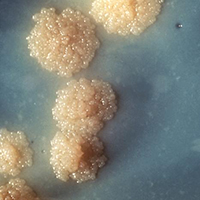Incidence rate and time to serious adverse events among rifampicin resistant tuberculosis patients in Georgia treated with new and repurposed anti-tuberculosis drugs, 2016-2018

Published: January 14, 2021
Abstract Views: 1655
PDF: 838
Supplementary: 134
Supplementary: 134
Publisher's note
All claims expressed in this article are solely those of the authors and do not necessarily represent those of their affiliated organizations, or those of the publisher, the editors and the reviewers. Any product that may be evaluated in this article or claim that may be made by its manufacturer is not guaranteed or endorsed by the publisher.
All claims expressed in this article are solely those of the authors and do not necessarily represent those of their affiliated organizations, or those of the publisher, the editors and the reviewers. Any product that may be evaluated in this article or claim that may be made by its manufacturer is not guaranteed or endorsed by the publisher.
Similar Articles
- S.M. Mirsaeidi, P. Tabarsi, M.O. Edrissian, M. Amiri, P. Farnia, S.D. Mansouri, M.R. Masjedi, A.A. Velayati, Primary multi-drug resistant tuberculosis presented as lymphadenitis in a patient without HIV infection , Monaldi Archives for Chest Disease: Vol. 61 No. 4 (2004): Pulmonary series
- Rupak Singla, Amitesh Gupta, Vikas Kumar, Chandrasekaran Padmapriyadarsini, Devika Tayal, Shweta Anand, Abhishek Faye, AK Hemanth Kumar, Madhumita Paul Choudhary, Study of risk factors and clinical management of patients with clinical non-response due to low plasma levels of anti-tubercular drugs , Monaldi Archives for Chest Disease: Early Access
- S.M. Mirsaeidi, P. Tabarsi, A. Mardanloo, G. Ebrahimi, M. Amiri, P. Farnia, M. Sheikhleslami, V. Bakayev, F. Mohammadi, S.D. Mansouri, M.R. Masjedi, A.A. Velayati, Pulmonary Mycobacterium Simiae infection and HTLV1 infection: an incidental co-infection or a predisposing factor? , Monaldi Archives for Chest Disease: Vol. 65 No. 2 (2006): Pulmonary series
- R. Luzzati, M. Confalonieri, A. Cazzadori, P. Della Loggia, R. Cifaldi, C. Fabris, M. Biolo, M. Borelli, C. Longo, E. Concia, Prolonged hospitalisation for immigrants and high risk patients with positive smear pulmonary tuberculosis , Monaldi Archives for Chest Disease: Vol. 75 No. 2 (2011): Pulmonary series
- Alessandra Schiavo, Francesca M. Stagnaro, Andrea Salzano, Alberto M. Marra, Emanuele Bobbio, Pietro Valente, Simona Grassi, Martina Miniero, Michele Arcopinto, Margherita Matarazzo, Raffaele Napoli, Antonio Cittadini, Pregabalin-induced first degree atrioventricular block in a young patient treated for pain from extrapulmonary tuberculosis , Monaldi Archives for Chest Disease: Vol. 87 No. 3 (2017)
- Seyed Hamid Borsi, Homeira Rashidi, Maryam Shaabanpour, Hanieh Raji, The effects of inhaled corticosteroid on insulin sensitivity in asthmatic patients , Monaldi Archives for Chest Disease: Vol. 88 No. 1 (2018)
- Kiran B, Rupak Singla, Neeta Singla, Vinay V, Kuljeet Singh, Madhumita Paul Choudhury, Nilotpal Bhattacherjee, Factors affecting the treatment outcome of injection based shorter MDR-TB regimen at a referral centre in India , Monaldi Archives for Chest Disease: Vol. 93 No. 3 (2023)
- A.E. Erbaycu, Z. Taymaz, F. Tuksavul, A. Afrashi, S.Z. Güçlü, What happens when oral tuberculosis is not treated? , Monaldi Archives for Chest Disease: Vol. 67 No. 2 (2007): Pulmonary series
- Varvara Solodovnikova, Ajay M.V. Kumar, Hennadz Hurevich, Yuliia Sereda, Vera Auchynka, Dzmitry Katovich, Dzmitry Klimuk, Aliaksandr Skrahin, Svetlana Setkina, Iryna Charnysh, Askar Yedilbayev, Alena Skrahina, Effectiveness and safety of delamanid- or bedaquiline-containing regimens among children and adolescents with multidrug resistant or extensively drug resistant tuberculosis: A nationwide study from Belarus, 2015-19 , Monaldi Archives for Chest Disease: Vol. 91 No. 1 (2021)
- C. Incorvaia, C. Pravettoni, M. Mauro, M.-R. Yacoub, F. Tarantini, G.G. Riario-Sforza, Effectiveness of omalizumab in a patient with severe asthma and atopic dermatitis , Monaldi Archives for Chest Disease: Vol. 69 No. 2 (2008): Pulmonary series
You may also start an advanced similarity search for this article.

 https://doi.org/10.4081/monaldi.2021.1649
https://doi.org/10.4081/monaldi.2021.1649




